The Gypsy Vanner in North Eastern U.S.A.
By Nikki Alvin-Smith

As a kid growing up in England and always out and about on the narrow winding country roads astride a pony, I would meet gypsy horses pulling their caravans or ‘vardos’ every summer. Occasionally the driver would shout out and offer us a donkey or horse they had for sale, or even jokingly offer to buy the beast upon which I rode.
The Romany is a traditional part of English culture as are the horses that toil each day alongside them. Just as in other parts of the world, nomadic life is fast disappearing. However, the horse, the so called ‘ Gypsy Vanner ‘ has become increasingly popular this side of the Atlantic.
The Vanner’s heritage stems from breeds such as Shires, Irish Cob, Fell and Dale ponies and much more and as a breed it is a veritable melting pot of horse breeds, much as the pot that sits over the gypsy campfire, who really knows what is in it or where the ingredients came from after all?
It has occurred to some forward thinking Vanner horse lovers that the region of the North 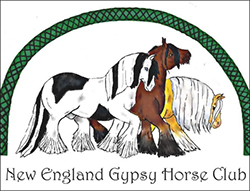 Eastern U.S.A. is poorly served as far as events and outlets for the Vanner to be showcased. The nearest opportunities for showing the Vanner at recognized events are huge distances and this has curtailed the development of the breed in the region. Hence the need for a new club, and the New England Gypsy Horse Club has been formed to fulfill that role. A hearty group of Vanner owners and aficionados that have started out in full force pulling that heavy cart from a starting out point as a small association to a full blown 501 c offering its first annual competition event on September 30th/October 1st at the Schaghticoke Fairgrounds, NY.
Eastern U.S.A. is poorly served as far as events and outlets for the Vanner to be showcased. The nearest opportunities for showing the Vanner at recognized events are huge distances and this has curtailed the development of the breed in the region. Hence the need for a new club, and the New England Gypsy Horse Club has been formed to fulfill that role. A hearty group of Vanner owners and aficionados that have started out in full force pulling that heavy cart from a starting out point as a small association to a full blown 501 c offering its first annual competition event on September 30th/October 1st at the Schaghticoke Fairgrounds, NY.
The Merry Band at the Catskill Horse is pleased to help spread the word about this exciting new club, and I sat down with board members Barb Elliot and Misha Duvernoy to learn more about the mission, plans and developments of the New England Gypsy Horse Club. Here’s what they had to say.
I asked Barb Elliot the reason for forming a club and she explained,
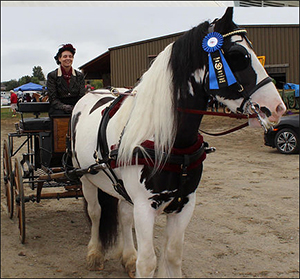 “We are a bunch of like minded gypsy horse owners that have the same goals in mind as stated in our mission statement. Before we started our Gypsy Horse club, the breed shows available to us required driving 900 to 1000+ miles to reach the closest ones (either NC or upper Midwest). Hardly do-able for most of us!
“We are a bunch of like minded gypsy horse owners that have the same goals in mind as stated in our mission statement. Before we started our Gypsy Horse club, the breed shows available to us required driving 900 to 1000+ miles to reach the closest ones (either NC or upper Midwest). Hardly do-able for most of us!
Through networking in various online Gypsy groups we found a bunch of us that all had the same desires, to make it possible to provide a venue to exhibit our great horses. So, we formed a group, New England Gypsy Horse Club (NEGHC). We held elections, started accepting paid members and obtained a 501(c)7 designation (not for profit club designation), and started planning a show. We are getting down to the wire with regards to the show. “
Misha Duvernoy, the chairmadam of NEGHC and Barb Elliot, President of the NEGHC, addressed several questions we asked pertaining to the new club.
CH: What inspired you (the board members) to start this club?
Barb: When many of us first acquired our Gypsy Horses, showing and exhibiting them  was definitely an option floating around in the back of our minds. Having to drive 900 to 1,000 miles to do that was an unrealistic event for most of us. Through a ton of networking on Facebook over a period of time, and meeting a few people face to face at events like Equine Affaire, and realizing just how many Gypsies were actually located in the northeast quadrant of the country, we decided to get together and form a club – with goals in the future for a centrally located show.
was definitely an option floating around in the back of our minds. Having to drive 900 to 1,000 miles to do that was an unrealistic event for most of us. Through a ton of networking on Facebook over a period of time, and meeting a few people face to face at events like Equine Affaire, and realizing just how many Gypsies were actually located in the northeast quadrant of the country, we decided to get together and form a club – with goals in the future for a centrally located show.
Although we are well acquainted online, only a few of us have met ‘in-the-flesh’. We are looking forward to our first event to get to know each other on a personal basis!
CH: Can you give me a little background about yourself and how you came to be involved with the Gypsy Vanner breed and what previous experience with horses/background you have?
Barb: I am very new to owning a gypsy horse. About 14 years ago, I had an online friend from England that bred registered Limousin cattle and sheep. She came to visit us on our 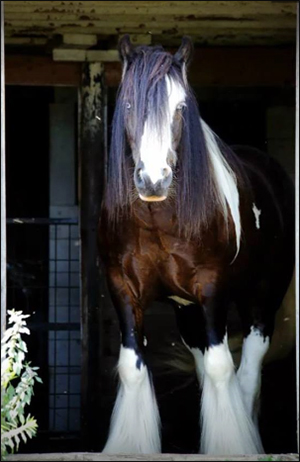 dairy farm on her way to a beef breeders conference out west. She called our ‘scrawny’ dairy cattle “hat-racks”, as opposed to her nice chunky beef cattle! She visited our area for a few days and she then continued on her journey. We had a great time and in discussing all our animals, we eventually got around to horses. I had four horses at the time and have owned horses all my adult life along with being a dairy farmer all my adult life. My friend indicated she had a few mares she bred, calling them ‘Vanners’. With her very strong English accent, I could not understand what she was saying as I had never heard of the breed before. I had to have her repeat the name several times and finally write it down before it was clear to me. She referred to them as ‘vanners’ but told me they were really Gypsy Vanners. She sent me pictures of her horses when she returned home (a mare and foal) and from that day on I was smitten. That was my introduction to the Gypsy breed. I followed the breed for years, but never had time or funds enough until recently to truly get involved personally with these great animals. I currently own a two year old and a three year old Gypsy mare, and a two year old Drum filly.
dairy farm on her way to a beef breeders conference out west. She called our ‘scrawny’ dairy cattle “hat-racks”, as opposed to her nice chunky beef cattle! She visited our area for a few days and she then continued on her journey. We had a great time and in discussing all our animals, we eventually got around to horses. I had four horses at the time and have owned horses all my adult life along with being a dairy farmer all my adult life. My friend indicated she had a few mares she bred, calling them ‘Vanners’. With her very strong English accent, I could not understand what she was saying as I had never heard of the breed before. I had to have her repeat the name several times and finally write it down before it was clear to me. She referred to them as ‘vanners’ but told me they were really Gypsy Vanners. She sent me pictures of her horses when she returned home (a mare and foal) and from that day on I was smitten. That was my introduction to the Gypsy breed. I followed the breed for years, but never had time or funds enough until recently to truly get involved personally with these great animals. I currently own a two year old and a three year old Gypsy mare, and a two year old Drum filly.
Misha: I grew up riding Morgan Horses and first saw a Gypsy in a magazine in the mid 90’s. At that time the pricing was very high because of the costs of importing, I thought I’d never get one. Several years later I met my first Gypsy at Equine Affaire and realized that the disposition was even more alluring than the physical beauty of the breed. Soon after, my husband and I visited a Gypsy Farm looking for a piebald gelding. I’m a gelding person, but was taken back by the non-marish dispositions of the Gypsy mares and the sweet disposition of the stallions. We both fell in love with a black blagdon filly, who would later be named WHR Sugar Hill Teagan. We brought Teagan home just after Christmas that year. We currently have three mares and are expecting a foal in the spring. We have proudly bred and raised two foals so far. We enjoy meeting new people through the breed, especially the owners of our 2016 filly, Sugar Hill Ailish West.
CH: Can you give us a brief background about the breed?
Barb: The breed originated with varying amounts of Fell and Dales pony blood, with generous amounts of Clyde and Shire blood. Action was contributed by topping off with 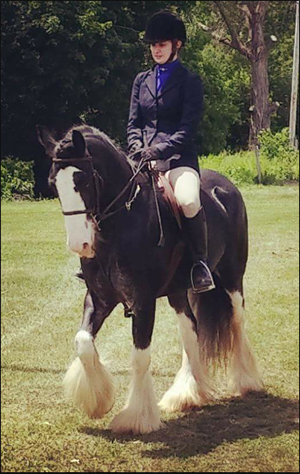 accents of Hackney and Welsh pony blood. Their height has undergone some trending with the reports in 1993 of the breed commonly being 15+ hands, but since then, commonly being found between 14-15 hands. Lately, a popular trending decrease in size to 12-13 hands height has been also common.
accents of Hackney and Welsh pony blood. Their height has undergone some trending with the reports in 1993 of the breed commonly being 15+ hands, but since then, commonly being found between 14-15 hands. Lately, a popular trending decrease in size to 12-13 hands height has been also common.
The Gypsy breed is not without controversy. Where the breed ‘originated’ varies, depending on who is asked. But general consensus has it originating in Ireland (as the Irish cob), having representatives brought to England to be used extensively and bred extensively by the Romany peoples (the migrant ‘gypsies’) that roamed through the English countryside, living in their caravans or ‘vardos’ as they are traditionally named. The vardo is typically a brightly colored, wooden wheeled, very elaborately decorated, curved roofed wooden ‘mobile ‘ home. It contained complete living quarters, with a bed/small wooden cook stove, windows and everything a gypsy family needed to call home. These living-quarters were pulled, obviously, by the ‘Gypsy’ horses. With the exportation to the US starting in 1996, the Gypsy breed has grown in popularity, and now has exports to many continents around the globe.
CH: What are the main features of the breed and strengths in terms of use?
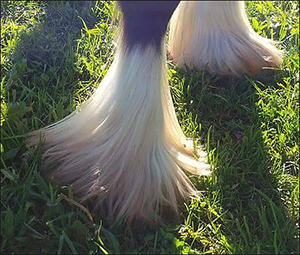 Barb: Probably they are generally most known for their beauty, heavy feathering, and long flowing manes and tails. But as a breed characteristic, their most notable strength is their easy-going character/kind nature/ and versatility. These horses have draft blood in them, along with different breeds of ponies and were truly developed to be a working breed. The breed is known by many different names; Irish Cob, Cob, Tinker, Gypsy, Gypsy Vanner, Vanner. But, no matter the name, they are extremely intelligent, tractable, and very versatile. They excel at driving, adapt well to English and Western disciplines, trail riding, and are making inroads into the dressage arena. They are also very people oriented and very much enjoy regular human interaction. The Romany peoples required a breed that was easily handled/adaptable to many situations, and able to work. This represents the ideals strived for today regardless of which registry one looks at.
Barb: Probably they are generally most known for their beauty, heavy feathering, and long flowing manes and tails. But as a breed characteristic, their most notable strength is their easy-going character/kind nature/ and versatility. These horses have draft blood in them, along with different breeds of ponies and were truly developed to be a working breed. The breed is known by many different names; Irish Cob, Cob, Tinker, Gypsy, Gypsy Vanner, Vanner. But, no matter the name, they are extremely intelligent, tractable, and very versatile. They excel at driving, adapt well to English and Western disciplines, trail riding, and are making inroads into the dressage arena. They are also very people oriented and very much enjoy regular human interaction. The Romany peoples required a breed that was easily handled/adaptable to many situations, and able to work. This represents the ideals strived for today regardless of which registry one looks at.
CH: What is the club’s mission? Is it a 501c? Plans to make it one?
Barb: Our mission statement reads as follows:
“It is the intent and purpose of the New England Gypsy Horse Club to showcase the beauty and versatility of the Gypsy horse – independent of the name chosen to describe the breed. The club will also support all members as integral parts of the club and strive to educate and inform club members and the general public about the Gypsy horse its history, bloodlines, and care specific to owning Gypsy horses.
We will conduct gypsy shows and other equine related events both for exhibition and promotion of Gypsy horses, in both recreational and formal event settings. We will also have member benefits (show discounts/member only content/member listing only sales page. We as a club hope to strengthen relationships within the breed and between all breeds.”
NEGHC has applied for and received a 501-(c)-7 ‘not for profit’ social organization/club designation. We are a ‘not-for-profit’ club, which means if we receive donations – these donations are NOT tax exempt, although people can still choose to donate to us, those donations cannot be written off as exempt. As opposed to a 501-(c)-3 non-profit, whose tax deductions are all tax exempt.
We have a Board of Directors (elected positions) and Executive Committee (elected position), and by-laws.
CH: What is the biggest challenge/obstacle you have faced thus far?
Barb: So far, I feel our biggest challenge has been getting the word out regarding our existence. Secondly, it has been the anticipation of enough show participation to call the event a success (translation – having the show pay for itself).
Misha: Starting a 501c7 and all of the steps to becoming a 501c7 has been a challenge. As a brand new club we are starting on the ground floor. We are proud of the support from our growing number of members and those who have donated to and sponsored our show. We could not do this show with out them. We are lucky to have such great support!
CH: What can members expect to gain from joining the club?
Barb: Ownership of a horse is NOT required for membership. We will continually advocate for our members to provide solid, horse-based information, and will attempt to procure discounts at various equine businesses. We currently have a 10% member discount at “Log Cabin Tack”.
CH: I know you have an event coming up. What can you tell us about it i.e. When? Where is it? What classes are offered? Is there stabling and what is the facility like?
Misha: The First Annual New England Gypsy Horse Club Gypsy and Open Horse Show, Sat 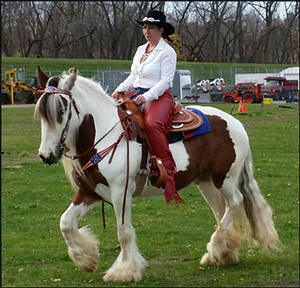 and Sun Sept. 30th + Oct 1st. We also have a clinic on Showmanship and Trail on Friday night September 29th, 2017. We are a GVHS sanctioned show offering a double judged, double ribbon, double point format. We are extremely happy to have two very well respected, high quality judges; Jennifer Moshier and Sandy Croote. The show is located at The Scahghticoke Fairgrounds, Schaghticoke, NY which is about halfway between Saratoga Springs and Albany, east of Interstate 87. There is plenty of stabling, and there is a very nice indoor main ring, along with several outside rings. We offer classes for people of all abilities. From Western, English, Driving, Ranch Riding, Dressage Suitability to fun classes like Sit-A-Buck with divisions for Green Horses, Beginners, 40+ year old riders, Youth and Leadline there is something for everyone.
and Sun Sept. 30th + Oct 1st. We also have a clinic on Showmanship and Trail on Friday night September 29th, 2017. We are a GVHS sanctioned show offering a double judged, double ribbon, double point format. We are extremely happy to have two very well respected, high quality judges; Jennifer Moshier and Sandy Croote. The show is located at The Scahghticoke Fairgrounds, Schaghticoke, NY which is about halfway between Saratoga Springs and Albany, east of Interstate 87. There is plenty of stabling, and there is a very nice indoor main ring, along with several outside rings. We offer classes for people of all abilities. From Western, English, Driving, Ranch Riding, Dressage Suitability to fun classes like Sit-A-Buck with divisions for Green Horses, Beginners, 40+ year old riders, Youth and Leadline there is something for everyone.
CH: Do you need volunteer help for the day? If so who should people contact?
Barb: I am sure we will need volunteers. Anyone interested in volunteering can contact our Show Chairperson, Misha Duvernoy at neghcshow@gmail.com.
CH: Can you explain the membership options/fees and who should people contact to learn more?
Barb: We currently have 6 levels of membership: Individual- $35/year; Corporate - $50/yr; Youth- $20/yr. Associate(non-owners), - $25/yr; Family - $50 /yr; Individual Lifetime $300. Any interested persons can contact our membership committee Chairperson Louis Griggs at lgriggs.neghc@gmail.com
CH: What do you hope to see in the future for the club?
Barb: We hope to spread knowledge about the wonderful Gypsy Horse, support members and owners, thereby increasing opportunities for gypsy owners and for people interested in becoming involved with the breed.
Catskill Horse is pleased to support this new club and spread word of its existence and development. Please do the same and share a link to this article in your social media circles.


